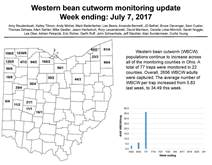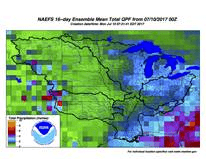This past week I had the opportunity to ride with a Hardin County farmer as he applied late season nitrogen to his corn. He had his sprayer rigged up with NDVI sensors that measure the amount dark green color in the corn which estimates the amount of nitrogen that the corn needs applied. There were four sensors across the sprayer boom which took an average reading and then an iPad in the cab calculated the amount of nitrogen to be applied on the go as we moved through the field. A nitrogen stabilizer was also mixed into the tank to help with possible nitrogen loss from possible lack of rain which helps to work the nitrogen into the soil as it is dribbled over the crown root of the corn using y-drop tubes. Most of the corn that day was needing 95-110 lbs of nitrogen per acre based on the recommendation provided by the software regulating the variable rate sprayer. The goal of this practice is to make more efficient use of nitrogen and apply it closer to the time when it is needed, and in this case it was applied to V9 growth stage corn.
Using a similar technique, last Friday I used a handheld NDVI sensor to take nitrogen readings in our nitrogen rate plot near Alger. This plot was consistently showing high rates of nitrogen across the field with corn in the V12 growth stage. These rates can then be plugged into a spreadsheet calculator to let you know how much nitrogen is needed based on a nitrogen rich strip. It factors in on-farm field research from Ohio and also takes into consideration normal yields, price of corn, and price of nitrogen. This type of technology is becoming more useful as we try to find ways of controlling input cost, while maintaining the best economically feasible yields for corn. Not only do we want to find the best rate of nitrogen to apply, but also want to limit the amount of nitrogen that is lost from run-off, leaching, and volatilization. These factors are often influenced by the weather but applying the recommended amount of nitrogen closest to the time it is needed by the growing crop limits the risk of nitrogen loss.
Don’t forget that tonight is the tree care program called ‘An Evening Garden Affair’ with tree expert Joe Puperi in Kenton. I have attached a flyer for more information about this program which will begin at 6:00 pm with a garden tour and speaker at 7:00 pm. It will be held at Harco Industries next to the Simon Kenton School. I also want to invite you to attend a dinner program being jointly sponsored by the Hardin County Farm Bureau and OSU Extension on Soil Health and Compaction Issues. Dr. Steven Culman, Soil Fertility specialist at The Ohio State University will be the guest speaker at an event being held Tuesday, August 1 at Mid-Ohio Energy Cooperative Community Room located at 1210 West Lima Street in Kenton. The program will begin at 6:30 pm with a catered meal, followed by a presentation by Culman. Dr. Culman is involved with new research which addresses issues with soil degradation in pipeline installations and approaches you can take to remediate compacted soils. Check out the attached news release and flyer to register for this event by Tuesday, July 25.
Soil Health and Compaction News Release
Western Bean Cutworm counts were up again for the week ending July 14 but not at economic levels in our area. See the article below for more information about this corn pest as well as other agronomy articles. Other upcoming events include a Farm Bureau meeting at 4:00 pm Tuesday, July 25 at the Heritage Barn on the fairgrounds. The Ohio State Fair begins Wednesday, July 26 and ends August 6 in Columbus so I hope you will have the opportunity to support the youth as I heard there are 96 4-H projects from Hardin County that qualified for the state fair this year and that doesn’t include the livestock entries. The Northwest OARDC Field Crops Field Day will be held Thursday, July 27 from 9:00 am-11:30 am at the Northwest research station near Custer in Wood County. Also the Hardin County Sheep Improvement Association will be operating the Lamb Stand at the Ohio State Fair ‘Taste of Ohio Cafe’ on Monday, July 31 so be sure to stop by for lunch if you are at there that day.
Mark
Determination of ear size in corn well underway – Peter Thomison
During the past two weeks, corn has “exploded” in growth in many Ohio fields. Under favorable growing conditions corn plants can grow nearly three inches per day between V8 (i.e., the eight leaf collar stage) and V15. However, there is considerable variability in corn development across the state, between neighboring fields, and within fields. Most of this variation can be attributed to planting date differences. Corn planted in mid to late April is at or beyond V13 whereas corn planted in early to mid-June is usually at stages no later than V3-4. Variation in growth and development is also related to differences in rainfall accumulation. Within fields, corn subject to ponding and prolonged anaerobic conditions often appears chlorotic and stunted and may be one to three leaf collar stages behind corn growing nearby under more favorable drainage conditions. To read more, go to https://agcrops.osu.edu/newsletter/corn-newsletter/2017-19/determination-ear-size-corn-well-underway.
Crops Under Water – Crop Stage is Critical for Recovery – Alexander Lindsey, Mark Sulc, Laura Lindsey, Peter Thomison
Large rain events seem to be trending this year in many parts of Ohio. These storms tend to last for a very short amount of time, but leave behind a large amount of water (2” or greater in many cases). This can lead to standing water (flood) conditions or waterlogged soils. In some localized areas, this may have resulted in partial and complete immersion of corn plants, especially in low spots and in river bottoms and along streams. Many crops are sensitive to excess water, but the amount of damage is typically driven by growth stage. Go to https://agcrops.osu.edu/newsletter/corn-newsletter/2017-22/crops-under-water-%E2%80%93-crop-stage-critical-recovery to read more about corn, soybean, and forage recovery from waterlogged soils.
Hay and Straw Barn Fires a Real Danger – Jason Hartschuh, Mark Sulc, Sarah Noggle, David Dugan
We’ve heard of one barn fire here in Ohio this morning and a lot of hay was put up last Thursday ahead of the rain. Much of the hay was wetter than it should have been for safe dry hay storage. Watch those moist bales very carefully for the next two to three weeks! Use a hay temperature probe and monitor the internal temperature of the hay during these first three weeks after baling. Usually, we think of water and moisture as a way to put a fire out, but the opposite is true with hay and straw, which when too wet can heat and spontaneously combust. This is more common with hay than straw because there is more plant cell respiration in hay. When baled at moistures over 20% mesophilic bacteria release heat-causing temperatures to rise between 130⁰F and 140⁰F. If bacteria die and bales cool, you are in the clear but if thermophilic bacteria take over temperatures can raise to over 175⁰F. Go to https://agcrops.osu.edu/newsletter/corn-newsletter/2017-19/hay-and-straw-barn-fires-real-danger to finish reading this article.
Western Bean Cutworm Monitoring Update for Week ending July 14, 2017 – Kelley Tilmon, Andy Michel
Participants: Mark Badertscher, Lee Beers, Amanda Bennett, Bruce Clevenger, Sam Custer, Thomas Dehaas, Mike Gastier, Rory Lewandowski, David Marrison, Cecelia Lokai-Minnich, Sarah Noggle, Adrian Pekarcik, Eric Richer, Garth Ruff, John Schoenhals, Jeff Stachler, Curtis Young, Chris Zoller: Western Bean Cutworm (WBCW) populations continue to increase across the majority of participating counties in Ohio. A total of 77 traps were monitored in 21 counties. Overall, 5208 WBCW adults were captured, almost double the amount of moths captured from the previous week (2751 WBCW moths). In addition, the average number of WBCW per trap increased from 37.2 last week, to 67.6 this week. Go to https://agcrops.osu.edu/newsletter/corn-newsletter/2017-22/western-bean-cutworm-monitoring-update-week-ending-july-14-2017 to see Ohio map and chart for WBC.
Manure Science Review on Wednesday, August 2 – Sarah Noggle, Glen Arnold
The 2017 Ohio State University Manure Science Review is scheduled for Wednesday, August 2nd at the Stoller Brothers & Sons farm west of Paulding, Ohio. The review will begin at 8:45 a.m. at the home farm located at 9257 Rd. 144, Paulding. Coffee and donuts will be offered in the morning before the field day kicks off with the afternoon activities ending by 3:30 p.m. The morning educational sessions in the farm shop will focus on effectively capturing manure nutrients, an update on the manure application regulations, what the Edge of Field studies are revealing about preventing the movement of manure nutrients, a panel discussion with local farmers on using cover crops, best management practices for handling poultry litter, and how to stay safe around manure structures. Go to https://agcrops.osu.edu/newsletter/corn-newsletter/2017-21/manure-science-review-wednesday-august-2 to find out more about this field day.
Mark A. Badertscher
Agriculture and Natural Resources Educator
OSU Extension Hardin County
1021 W. Lima Street, Suite 103, Kenton, OH 43326
419-674-2297 Office
hardin.osu.edu
















